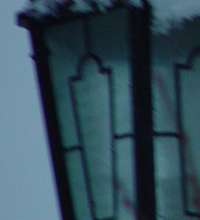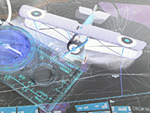 |
||
|
||
| ||
By Sergei
Penya
 The Sony digital photo cameras for data recording use untraditional storage devices. In the CYBERSHOT series they use Memory Stick cards, and in the Digital MAVICA they use 3.5" diskettes. And while there is no compatibility with the other part of digital photo world, inside Sony world (Memory Stick - a universal storage device for photo, video cameras, audio and video players, computers) and in the computer world (3.5" diskette) the compatibility is complete. If a diskette is not sufficient for the digital photo camera you can use the MSAC-FD2M adapter for the Memory Stick. The device will be useful both for data transfer into the computer and for replacement of the diskettes by Memory Stick cards in the Mavica cameras of the FD85, FD90, FD95 models.  In the Mavica MVC-CD 1000 photo camera the mini CD-R disc 8 cm in diameter is used as a storage device. The Mavica name (Magnetic Video Camera - a class os digital devices from Sony based on data recording electro-magnetic technology appeared in the early 80 of the last century) descends from the MVC - FD95. It is the same powerful and weighty camera with 10x optical zoom, Super Steady Shot system and 2.1 Mpixel charge-coupled device matrix. One of the special features of the camera is a unit which records data on the CD-R. The proprietary disc "for Mavica" can contain up to 156 MBytes data, and you can also receive a durable photo archive. At $4 for the disc even a usual photo film loses as far as cost for a still is concerned. The camera can only once record the CD, that's why availability of such discs will be defined by popularity of the camera and the mini CD recording technology. When switching on the camera it will every time recommend you the Mavica disc if you have installed another. After installation of a blank disc the camera starts initialization procedure which will last several minutes, after that you can start shooting. For viewing the shots on a computer with a usual CD drive without a special software the disc must be closed. Each closing procedure takes little free space (the first one takes more than 10 MBytes, the following ones take less). You should implement initialization and closing procedure with the feeding coming from the external power supply unit or from the completely charged batteries. It means that the batteries will be completely exhausted by these energy-intensive procedures. At the standard initialization-closing the battery's resource (1.5 hours) will decrease by 10-15 minutes. But even a slight failure (dirt on the disc, for example) can drag out the closing. For example, closing of a non-proprietary disc in one of the tests was 25 minutes long, and if the batteries had not been charged completely the data would have been lost due to breaking of the procedure. In this case I can recommend you not to stop closing, if the shots are valuable. With the DirectCD (Adaptec) software provided an unclosed disc will read on the CD drive of your computer. Unfortunately, the Direct CD version must be special for the Mavica, and today you can't download it for free.  You can work with the camera via a USB connector of the computer. Thus you will get an additional detachable CD drive. But apart from the vivid advantages of the CD-R technology, the camera features some downsides. When recording the shot you'd better avoid any vibrations, and when implementing initialization and closing procedures just do not touch the camera. But when we tested the camera we handled it as a usual photo camera, and no failures arose. So, I think that they meaningly mounted the CD recording unit on the heavy FD-95. CD recording makes shooting slower (you can work in the JPEG 1600*1200 format with the time interval less than 5-6 seconds, and in the TIFF 1600*1200 format with the time interval less than 30-40 seconds). The time needed for preparation of the camera after switching on is also quite long - 10-20 seconds. For CD-R device in the digital camera you need an additional capacious buffer, but it will raise the price even more. Technical characteristics and functions
 A shot of the spectrum. On the "red"-"green"the sensitivity decreases a bit.  Camera handling Camera control buttons: on/off, a "slider" of the zoom lens and sound volume, white choice and adjustment buttons, program buttons, flash elevation button, switches for photo/video/viewing and stabilization mode on/off, 4-position button for menu settings control with choice confirmation by pressing, a ring on the lens for manual focusing. The viewfinder gets on when the camera is brought close to the eye. The sharpness is automatically adjusted for the central part of the shot, you can also adjust it manually with the ring on the lens tube. The sharpness depth can be well seen both in the LCD and in the viewfinder. The manual focusing is electric, and when adjusting it depends not only on the turning of the focusing ring but also on its rotation speed. The camera in the auto focus and stabilization mode gets focused at and shoots slowly the distant objects (up to 2 sec). You can fix exposure and focusing having half pressed the release button, but the viewfinder will show the "frozen" picture of the possible future shot. Camera control via the display menu: "setup"  "camera" settings  "file" settings  "effect" settings Data processing menu:  You can view the shots in turn having chosen them or as a slide show. They can be rotated what is convenient for viewing them on TV, deleted (but this won't add the space on the disc), protected from deletion, marked for the further printing, saved into the camera buffer and recorded on another disc, scaled. Shot quality  The 6 - 60 mm optical zoom (39-390 mm eqv to a 35 mm shot) allows shooting both the whole architectural ensemble and just a part of it.   When shooting with the the long-focus lens you won't do without the Super Steady Shot system. The left shot was done with the system disabled at the 1/50 exposure and 390 mm focal length (for 35 mm shot), the right one - with the system enabled.  It's not very convenient to shoot at the long focus. The camera is preparing too long, and you have to hurry until the object sits still. After that, if an object is not in the center of the shot and is little in size, the auto focus can easily miss the mark. The powerful zoom of the lens for 390 mm will show you the whole range of the chromatic aberration. You can look at the shot fragment 357 KBytes in size here. The noise in the lights and shades is not considerable but it is noticeable in the whole range of brightness. With insufficient lighting the auto focusing of the camera works quite well. If the object in the shot's center gets in focus and there are no other targets equivalent in contrast, the camera will easily keep it in the focus even if it shifts up to 1/3 of the shot. The passive focusing works good when shooting through the glass.  For shooting you can choose one of the color balance settings: indoor, outdoor, auto or manual balance with the white sheet of paper. In order to define what "outdoor" or "indoor" corresponds to, you can make a shot of a white wall with different settings. The shooting results when illuminating with the luminescent lamp show that "indoor" is a incandescent lamp, "outdoor" is a day light, "auto balance" will handle any operation having just shifted white color toward the warm (yellow) colors. Image processing Standard shot  Negative  black-and-white  Sepia  Solarization  The camera has two shooting modes in twilight: Twilight and Twilight+. This modes are traditional for Sony and differ in exposure. In the Twilight+ mode the exposure equals 2 sec, in the Twilight it is 1/30 sec. The shot above was taken in the Twilight+ mode, with 2.8 aperture and ISO 80 "film". In the Twilight you will see nothing but windows. The "Panfocus" mode allows shooting landscape excellently. The focus sets in the "shortest" position. The hyperfocal length is the minimal distance, when the objects from "infinity" seem sharp on the shots. For the 39 mm focus and 11 aperture (0.035 mm permitted unsharp circle) the hyperfocal length makes 4 m. In the macro mode the camera works only with auto focus (only short focus). You can make a shot of a 40 mm object for the whole shot within 6.0-15.0 mm focus range. I recommend you to draw back slowly from the object at which the camera is already focused and increase the focal length. In this case you may avoid hardly noticeable barrel distortion at the shortest focus and shading of the object with the camera. The camera lacks only for a large buffer for successive
shooting (320*240 video clip does not still replace a photo) and
more reliable mounting onto the tripod. But the camera still has
a lens lid. Besides, the camera easily works with a TV set, but
it's exacting to a computer. And I also should note that it is not
simple to find drivers and programs for this camera on the Net.
Write a comment below. No registration needed!
|
Platform · Video · Multimedia · Mobile · Other || About us & Privacy policy · Twitter · Facebook Copyright © Byrds Research & Publishing, Ltd., 1997–2011. All rights reserved. |